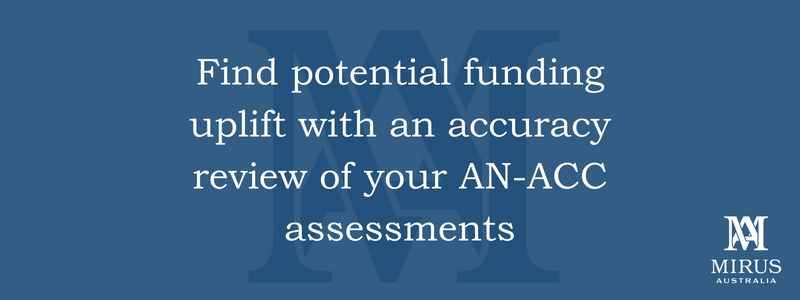How providers can optimise their AN-ACC funding
December 6, 2022 | AN-ACC

History shows us that every time the funding model changes for aged care, the industry struggles to adopt the new model and draw sufficient funding out of the system. We saw this happen with the change from RCS to ACFI. Although organisations and their funding teams continue to familiarise themselves with the AN-ACC assessment framework and how it links to each AN-ACC class, there is steep learning curve. A lack of knowledge is resulting in significant differences between forecasted and assessed AN-ACCs with a considerable proportion of the industry still working off their AN-ACC shadow assessments. This is being reflected in the overall average AN-ACC for the industry being several dollars below the $225 forecasted by the department.
We work with aged care providers to ensure they have the funding they are entitled to and embed a sustainable approach and provide assurance of accuracy of funding for years to come. This is essential to achieve the optimum funding for every facility and organisation and to provide the foundation of the new operating rhythm required to manage AN-ACC effectively. Transparency of your potential uplift and “downgrade” transactions will be required to manage the equilibrium between funding and care minutes, to keep your funding up and your rosters stable.
Here is one recent example of how we help providers to optimise their funding.
CASE STUDY
Meeting care minute targets, but missing revenue in reclassifications
Our client is a three facility, 240 bed provider of residential aged care in Sydney.
Classifications were in place for all residents and each of the three facilities were able to comfortably meet their care minute target. Many of the classifications, however, were still based on shadow assessments and many consumers who had changes in their care needs required reclassifications.
Our client submitted several unsuccessful attempts to obtain reclassifications that aligned to their residents’ care needs. In some cases, the outcomes meant receiving lower levels of funding and in other cases, the uplift was not as high as expected.
It became clear that staff were unsure of how the scores of each AN-ACC assessment would determine an AN-ACC class and that they were not aware of what the reclassification outcome on funding would be. This meant that revenue was unpredictable and difficult to control.
Building staff confidence in AN-ACC data and clinical documentation
Our consultants worked with clinical staff to build their confidence in linking AN-ACC assessments to AN-ACC classes.
We worked alongside the provider’s team to review the residents and accurately forecast or validate each consumer’s AN-ACC outcome. We then worked with staff to ensure that the clinical documentation within the Care Management System aligned with the consumers care need.
The coaching and planning for the reassessments resulted in 95% of the projected reclassifications being received along with the revenue uplift.
In control of AN-ACC data, and in control of revenue
240
residents’ classifications reviewed
54
AN-ACC reclassifications
1,100,000
$ of potential revenue uplift
95
% of revenue projection achieved
We have now supported thousands of reclassifications and have developed a deep knowledge of how to improve reassessment outcomes.
If you would like to understand the opportunities for your organisation, please contact us:


